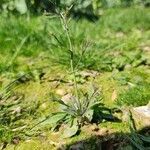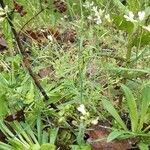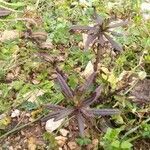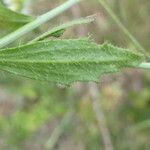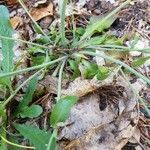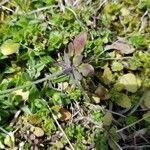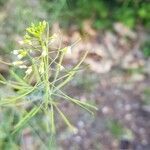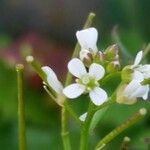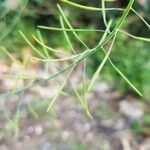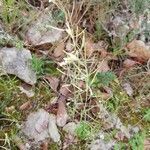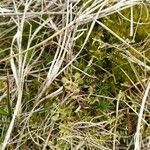Annuals; glabrous or pubescent, trichomes usually simple, sometimes mixed with stalked, forked ones. Stems simple or few from base, erect, unbranched or branched distally, (0.2-)0.5-3(-5) dm, pubescent basally, trichomes predominantly simple, glabrous apically. Basal leaves shortly petiolate; blades obovate, spatulate, ovate, or elliptic, 0.8-3.5(-4.5) cm × (1-)2-10(-15) mm, margins entire, repand, or dentate, apex obtuse, adaxial surface with predominantly simple and stalked, 1-forked trichomes. Cauline leaves subsessile; blade lanceolate, linear, oblong, or elliptic, (0.4-)0.6-1.8(-2.5) cm × 1-6(-10) mm, margins usually entire, rarely toothed. Fruiting pedicels divaricate, 3-10(-15) mm. Flowers: sepals 1-2(-2.5) mm, lateral pair not saccate basally, (glabrous or sparsely pubescent distally, trichomes simple); petals white, spatulate, 2-3.5(-4) × 0.5-1.5 mm, (base attenuate to claw); filaments 1.5-2 mm. Fruits cylindric or linear, smooth, terete, (0.8-) 1-1.5(-1.8) cm × 0.5-0.8 mm; valves each with distinct midvein; ovules 40-70 per ovary; style to 0.5 mm. Seeds light brown, (plump), ellipsoid 0.3-0.5 mm; cotyledons incumbent. 2n = 10.
Herbs annual, (2-)5-30(-50) cm tall. Stems erect, 1 or few from base, simple or branched above, basally with predominantly simple trichomes, apically glabrous. Basal leaves shortly petiolate; leaf blade obovate, spatulate, ovate, or elliptic, 0.8-3.5(-4.5) cm × (1-)2-10(-15) mm, adaxially with predominantly simple and stalked 1-forked trichomes, margin entire, repand, or dentate, apex obtuse. Cauline leaves subsessile, usually few; blade lanceolate, linear, oblong, or elliptic, (0.4-)0.6-1.8(-2.5) cm × 1-6(-10) mm, entire or rarely few toothed. Fruiting pedicels slender, divaricate, straight, 3-10(-15) mm. Sepals 1-2(-2.5) mm, glabrous or distally sparsely pubescent with simple trichomes, lateral pair not saccate. Petals white, spatulate, 2-3.5 × 0.5-1.5 mm, base attenuate to a short claw. Filaments white, 1.5-2 mm. Ovules 40-70 per ovary. Siliques linear, terete, smooth, (0.8-)1-1.5(-1.8) cm × 0.5-0.8 mm; valves with a distinct midvein; style to 0.5 mm. Seeds ellipsoid, plump, light brown, 0.3-0.5 mm; cotyledons incumbent. Fl. and fr. Jan-Jun(-Oct). 2n = 10*.
Slender annual or biennial herbs 5-25 cm high; lower part of stem densely puberulous with spreading simple hairs and sometimes with some branched hairs; upper part of stem glabrous or sparsely puberulous. Leaves mostly crowded into a rosette, 1-4 cm long, obovate to oblanceolate, entire or weakly dentate, petiolate; petiole with mostly simple hairs, blade on both surfaces scabro-puberulous with branched hairs; stem leaves few and small, sessile, lanceolate or narrowly oblong, usually entire, glabrous or sparsely puberulous. Raceme dense in flower, lax in fruit. Pedicels 0.5-1.2 cm long in fruit, slender, ascending or wide-spreading. Siliquae 1-2 cm long, 0.6-0.8 mm broad, linear; valves rounded on the back, 1-nerved; style very short. Seeds c.0.5 mm long, oblong, brown.
Annual herb; rosette small. Stems erect, 5-20-(40) cm tall, bearing patent simple hairs below. Lvs all hairy, with simple, 2-fid and branched hairs. Rosette lvs petiolate; lamina ovate to obovate, entire or very shallowly and bluntly toothed, (3)-5-25 × (2)-3-10 mm. Stem lvs few, smaller, simple, sessile, obovate to narrow-ovate, cuneate at base. Racemes 10-20-(40) cm long. Pedicels slender, erecto-patent, spreading at fruiting, 5-7 mm long. Sepals oblong, 1-1.5 mm long, glabrous or with a few hairs at apex. Petals white, narrow-obovate, 2.5-3.5 mm long. Stamens 6, rarely 4, slightly < petals. Silique held at slight angle to pedicel, curving upward, glabrous, (8)-10-15 × c. 0.5 mm; style c. 0.2 mm long. Seeds brown, 0.3-0.5 mm long, in 1 row per locule.
Slender herb to 70 cm tall, simple or branched, hairy; hairs simple and branched. Basal leaves rosulate, elliptic or spathulate, dentate to entire; cauline leaves sparse, reducing to lanceolate, entire, sessile. Inflorescence a raceme elongating from a terminal corymb. Sepals to 2 mm long. Petals to 4.5 mm long, white. Style less than 0.5 mm long, stigma capitate. Siliqua linear, 9–30 mm long, 0.7 mm wide, somewhat curved; valves glabrous, convex with a prominent central branched vein; pedicels slender, spreading, to 1 cm long. Seeds ovoid, 0.5 mm long.
Annual or winter-annual 1–4 dm; lvs chiefly in a basal rosette, oblong to spatulate, 1–5 cm, stellate-hairy; cauline lvs smaller, linear to narrowly oblong; sep pilose; pet 2–3 mm; mature racemes very open, the widely divergent pedicels 5–10 mm; frs divergent or ascending, 1–2 cm × 1 mm; 2n=10. Native of Europe, naturalized in fields and waste places, especially in sandy soil, throughout most of the U.S. Apr.–June. (Sisymbrium t.)
